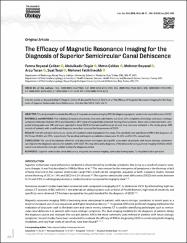The efficacy of magnetic resonance imaging for the diagnosis of superior semicircular canal dehiscence

Göster/
Erişim
info:eu-repo/semantics/openAccessTarih
2018Yazar
Çeliker, Fatma BeyazalÖzgür, Abdulkadir
Çeliker, Metin
Beyazal, Mehmet
Turan, Arzu
Terzi, Suat
İnecikli, Mehmet Fatih
Üst veri
Tüm öğe kaydını gösterKünye
Beyazal Çeliker, F., Özgür, A., Çeliker, M., Beyazal, M., Turan, A., Terzi, S., & İnecikli, M. F. (2018). The Efficacy of Magnetic Resonance Imaging for the Diagnosis of Superior Semicircular Canal Dehiscence. The journal of international advanced otology, 14(1), 68–71. https://doi.org/10.5152/iao.2017.4103Özet
OBJECTIVE: This study aimed to evaluate the efficacy of magnetic resonance imaging (MRI) for diagnosing superior semicircular canal dehiscence (SSCD). MATERIALS and METHODS: the radiological records of patients who were admitted to our clinic with complaints of otologic and neuro-otologic symptoms between October 2014 and December 2015 were retrospectively reviewed. Among these patients, those who underwent both computed tomography and MRI and were reported to have SSCD in the temporal bone on at least one side were included in the study group. MRI records of patients with a confirmed diagnosis were then assessed for the presence of SSCD. RESULTS: the left and right semicircular canals of 52 patients were evaluated in this study. the sensitivity and specificity of MRI in the diagnosis of SSCD was 89.06% and 90%, respectively. the positive and negative predictive values were 93.44% and 83.72%, respectively. CONCLUSION: the use of multiplanar reformats and angulation techniques during MRI assessment of patients with neuro-otologic symptoms can improve the diagnostic process for patients with SSCD. This may allow early diagnosis of the disease by using just one imaging method, which would also reduce the costs per patient during the diagnosis period.

















